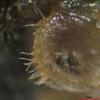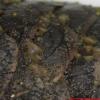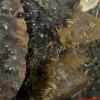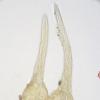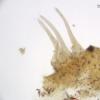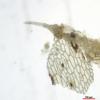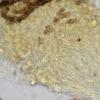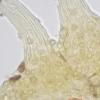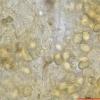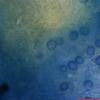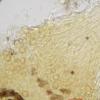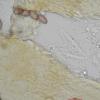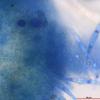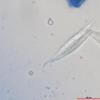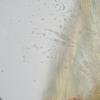
02-01-2026 17:43
MARICEL PATINOHi there, although I couldn't see the fruitbody, I

04-01-2026 17:45
 Stephen Martin Mifsud
Stephen Martin Mifsud
I was happy to find these orange asmocyetes which

03-01-2026 13:08
Niek SchrierHi all,We found groups of perithecia on a Lecanora

29-12-2025 17:44
Isabelle CharissouBonjour,J'aimerais savoir si d'autres personnes au

01-01-2026 18:35
Original loamy soil aside a artificial lake.The co

31-12-2025 19:27
Collected from loamy soil, at waterside (completel
I've been reading this great forum for a while and now I need your help.
At the beginning of November, Elisabeth Stöckli showed me ascomycetes on urinophilic sites.
Among other things, we found a cone of Picea abies on a moss cushion, soaked in urine. Ascobolus sp. were fruiting on it (presumably A. lignatilis).
At home I noticed that many small perithecia of another Ascomycete had grown on the Ascobolus and the cone. It took me some time to come to the genus Pyxidiophora.
Perithecium: subglobose, amber-coloured and occasionally with thick-walled, septate hyaline hairs about 5 my wide. At the transition to the rostrum partly with thin-walled, hyaline hairs about 2 my wide. Rostrum distinctly lighter in colour (clearly demarcated), slightly conical, very long and slender. Apically pointed. Straight to slightly curved.
Rostrum: Pigment distinctly lighter in colour. Very long conical cells from base to apex (basal 7 my, apical 3 my) with a thicker cell wall. Cells septate ( 5-7).
Peridia: At the base with rectangular cells. The cells are thin-walled and become increasingly square and polygonal towards the rostrum. Some of the cells are almost round. On the outside of the peridia are partly thick-walled, roundish to oval elements that are caynophilic. I cannot judge these elements.
Spores: hyaline, fusiform/clavate in a gel sheath. Many spores apically with a dark brown body. Lower third septate. Basally straight or strongly curved.
All pictures in tap water, except 3 pictures in cotton blue.
Perithecium: (without rostrum)
(84) 110.67 (136) x (74) 86.92 (97) n=12
Rostrum:
(206) 253.5 (318) x (17) 26.22 (35) n=12
Spores:
(58.42) 65.10 (71.71) x (5.23) 6.21 (7.35) n=11
An exsiccate is on its way for sequencing, although I know that not many Pyxidiophora sequences have a species name.
Thank you very much for your support.
I wish you all a Merry Christmas and a Happy New Year.
Simon

A very difficult type that is rarely encountered and it is even rarer to find it on a Pezizale. It seems that some spores have a spot on the more rounded side and that the asci have more than two or three spores. Is this correct?
Michel.
what I would like to add
I have consulted various literature.
Lundqvist 1980
Doveri 2006
Breton & Faurel 1967 Mycorhynchus
and others
At the beginning I liked P. arvernensis. However, the rostrum is described much shorter and the substrate is dung.
P. marchalii was also a candidate. Here, however, the perithecium is much broader and the spores are also less broad.
In addition, the colour of the rostrum is much darker, also on dung.
The substrate of my find gives me a big headache. Is it possible to equate urinophilous with coprophilous? Both substrates have a greatly increased nitrogen content. Or do I have to look for the mycoparasitic species?
Greetings, Simon
yes, I would see it the same way.
I'm not sure if I've seen Asci. I could not colour the ascus wall of the spore clusters.
The number of spores per asci gave me the impression that there could be 4 or slightly more.
Simon

I also went to marshalii, and the differences you point out do not shock me because by rereading your description the measurements you give are within the measurement range of several authors.
thanks for your opinion.
I have already exchanged views with other people before posting in the forum. That's when the species P. marchalii came into play. At least something similar.
I'll take a closer look at P. marchalii again.
Simon

Perhaps I made a mistake in my first description of my find.
I stated the dimensions of the perithecium as length (height) x width.
In the studied literature, the length (height) is not given much importance.
Doveri 2006 speaks only of diameter (width)
In my new measurements and review of my notes, I focussed on the diameter of the perithecia.
About the substrate:
In the Encyclopedia of Mycology (2021) there is a very interesting report on Pyxidiophora by Danny Haelewaters.
It mentions that various experiments have led to the conclusion that most Pyxidiophora species are mycoparasitic or at least thrive better in association with suitable fungi (p. 275).
For this reason, the question of the substrate is no longer so relevant for me.
Literature references (measurements) for P. marchalii
Rhynchomyces marchalii Sacc. in Marchal, Bull. Soc. R. Bot. Belg. 24(1): 60 (1885)
Perithecium:
Length 145-160 x width 110-125
Rostrum:
length 225-265 x width 35-45
Spores:
Length 65-70 x width 5.4-5.6
Mycorhynchus marchalii, in Breton & Faurel 1967 RevMyc 32(4) 1967
Perithecium:
Length 145-160 x width 110-125
Rostrum:
Length 225-265 x width 35-45
Spores:
65-70 x 5.4-5.6
Breton & Faurel emphasise the width of the perithecium in their key.
The first question under 1 is Perithecia up to 100 or larger. If you answer this question with up to 100, which is clearly the case with my fruiting bodies, 3 species remain.
These are
M. petchii
M. arvernensis
M. schotterianus
Mycorhynchus marchalii (Sacc.) Mig., in Trans. Br. mycol. Soc 68 (3) 329-340 (1977), Hawksworth & Webster
Perithecium:
110-125 (diameter)
Rostrum225-265
Spores:
65-70 x 5.4-5.6
Pyxidiophora marchalii, in Doveri & Coué 2006
Perithecium:
Diameter 110-125
Rostrum:
Length 250-320
Spores:
fusiform, sometimes with a filiform base, 65-70 x 5.5-5.6
Key from Doveri:
Question 1 deals with the substrate. I went both ways
Doveri combines the question on perithecia width under 4 with the length of the spore
spores longer than 65 and perithecium diameter wider than 100 to 5
or, spores shorter than 65 and less than 100 in diameter to 6.
The average spore length in my case is 65.10. So answers 5 and 6 are possible. If you add the diameter of the perithecia, you get 6.
P. petchii, P. grovei and P. schotteriana are worth considering, but they also leave many questions unanswered and do not really fit. Perhaps P. grovei comes closest, but the spores are too narrow.
Own measurements: according to notes
Perithecium diameter (width):
86
87
74
76
83
81
84
82
82
76
88
86
80
85
80
94
88
80
57
97
n=20 Average 82.3
Rostrum length:
236
297
238
214
206
220
286
293
243
270
318
Spore, width measured without gel cover:
71.71 x 6.25
71.00 x 5.74
58.42 x 5.66
66.32 x 6.83
64.46 x 5.23
61.00 x 5.86
64.13 x 5.72
58.94 x 6.82
67.50 x 6.41
65.34 x 7.35
67.23 x 6.43
n=11 Average width 6.21
Own measurements newly measured with piximeter 30.12.2023
Perithecium diameter (width)
90
99
91
95
78
109
107
74
80
102
110
76
83
72
81
87
99
75
80
82
n=20, average 88.5
Rostrum length, width at the base, width at the apex (below the taper)
233 - 39 - 16
300 - 43 - 16
207 - 34 - 18
212 - 47 - 18
209 - 35 - 15
211 - 44 - 16
235 - 35 - 19
221 - 46 - 19
158 - 45 - 19
300 - 38 - 17
302 - 38 - 16
288 - 38 - 21
I have been studying P. marchalii intensively over the last few days and weeks.
For the following reasons I am of the opinion that it cannot be P. marchalii.
Perithecia diameter on average from all measurements 85.4 ,n=40 and thus clearly smaller than P. marchalii 110-125
Spore width 6.21 , clavate/fusiform (P. marchalii 5.4-5.6, fusiform)
I wish you a good start into the new year
Simon

Best wishes 2024.



